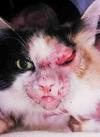Causes and Treatment of Feline Skin Lesions
"Feline skin lesions have many possible causes including allergy, infections and parasites. Diagnosis of skin problems in cats can be a challenge since cats have a tendency to lick or use their teeth on itchy areas. Licking can cause lesions to become infected and hair loss. The leading cause of skin lesions in cats are fleas, which are often the problem despite the owners ability to locate a flea on the cats body. For example, a human could carry fleas into a house, which in turns causes a cat skin reaction. The second leading cause is atopy, which is an allergy to inhaled substances such as tree and grass pollen. A visit to a veterinarian is required for a specific diagnosis and treatment recommendation. Certain causes can be suspected based on a cats history and location of the cat skin disorder."
There are many possible causes for feline skin lesions. The
treatment depends on the type and cause of the sore. Anytime your cat
has a sore that doesn’t heal in a few days or that oozes yellow or
green-colored puss, see your vet as this is a sign of infection.
Start by suspecting the leading cause which is fleas, even if you have
trouble locating any on your cat's body. If you cat has flea
protection, next suspect atopy (seasonal allergy) or food allergy as
the cause. After allergy, problems such as ringworm and scabies are
potential causes. Problems such as infection are often introduced into
the skin after a cat licks itchy areas, a condition referred to as a
secondary skin infection.
Diagnosis of Feline Skin Lesions
There are several factors that could provide clues as to the cause of the cat skin disorder.
Age of Your Cat: Younger cats could be suffering from something inherited from the parents, skin infection. Middle age cats tend to have a problem with hormones or some type of allergy. Older cats might have a tumor which is either cancerous (malignant and fast spreading) or benign (not cancerous or fast spreading).
Seasonality: In the summer months problems could be related to seasonal allergy such as pollen (Atopic dermatitis) or insect bite. Dust mites are seen more often in winter.
Medications: New products that you might be using with your cat such as flea collars or spot ons might cause the problem.
Other Symptoms: Symptoms that your cat may be suffering from besides the skin problem could be telling:
- Red Eyes (conjunctivitis) and Swelling: could indicate allergy to food or something in the environment.
- Diarrhea:
Feline skin lesions and diarrhea could be a sign of food allergy or a
reaction to food.
- Unusual Thirst or Frequent Urination: Sign of hyperadrenocorticism.
- Weight Loss, stomach or breathing problems: These are associated with yeast or fungus infection.
The location of the feline skin lesion could indicate a possible cause.
Location Of The Skin Lesion |
|
|---|---|
|
Location |
Possible problem |
|
Ears |
Skin allergy, food reaction, parasite problem, infection from a medical condition somewhere else in the body, polyp which is a raised skin tumor |
|
Head and Face |
Skin allergy, food reaction, fungal infection, insect allergy, scabies, blisters |
| Paws | Skin allergy, food reaction, blisters, skin injury |
| Claws | Bacterial infection, immune system reaction |
|
Base of Tail, Hair loss along the spine |
Flea problem |
Other Causes of Feline Skin Lesions:
Acute Moist Dermatitis (cat hot spots)
Acute moist dermatitis, or “hot
spots,” are round, raw lesions that occur most often on the head, hips,
and sides of the chest. They are most common on cats with long, dense
hair, and occur most often during times of hot weather. Hair usually
falls out in these areas. The skin becomes very irritated and cats will
often lick and bite at the area.
Hot spots can be caused by a number of things, including flea bites, mites, poor grooming, and allergies. You vet can make a diagnosis after examining your cat. Treatment depends on the cause. Clipping the hair around the lesions makes it easier to clean and treat the feline skin lesions. If they are infected, oral antibiotics will be prescribed. Treatment will be prescribed for fleas or other parasites, and your vet can instruct you on proper grooming techniques.
Feline Demodicosis (Mites)
Demodicosis is a condition
caused by mites. It causes feline skin lesions that ooze and crust over
and also causes hair loss. This may occur in one small area or may
occur all over the body.
To diagnose demodicosis, you vet will do a scraping of the affected skin and examine it under a microscope. If your cat has this condition, it is usually treated with a topical medication, although sometimes it is also treated with an oral medication as well.
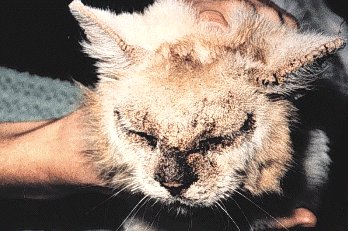
Picture of Cat Skin Problem Mange (also called scabies and demodicosis)
Consider a natural treatment for this
condition such as the dip offered by Naturasil.
This product
has the added advantage of mixing with your cat's current shampoo,
making the treatment more familiar to your cat and manageable for you.
In order to avoid re infestation, a cats environment should be cleaned with a quality disinfectant such as Benzarid. All belongings should be washed with a liquid detergent and all rooms should be thoroughly vacuumed.
Feline Blastomyhcosis
Blastomycosis is a fungal
infection that causes cat skin sores. It is a systemic infection
that
causes respiratory problems, generalized weakness, a poor appetite, and
even blindness. One of the first signs of the illness, however, is
round, oozing sores on the skin. The sores may later crust over. Cats
with this condition often have difficulty breathing and have a chronic
cough.
To diagnosis blastomycosis, your vet will examine secretions from the sores under a microscope. Blastomycosis is treated with an oral anti-fungal medication using traconazole (ITZ) therapy.
Feline Histoplasmosis
Histoplasmosis is a less common
fungal infection. Like blastomycosis, it is a systemic infection and
causes weight loss, cough, fever and diarrhea. It can also cause feline
skin lesions. It is diagnosed and treated the same way blastomycosis is.
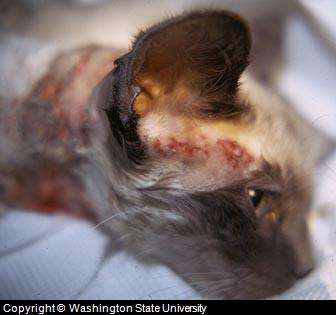
Cat Skin Lesions due to Fungal Dermatitis on Face
Cat Skin Allergies
Cat Allergies can cause feline skin lesions. These are usually in the form of raised red bumps known as hives. They are itchy and will cause your cat to scratch. Excessive scratching may break the skin, leading to infection.
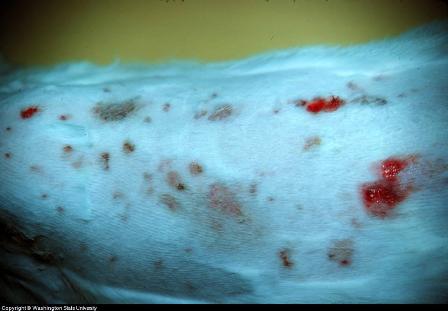
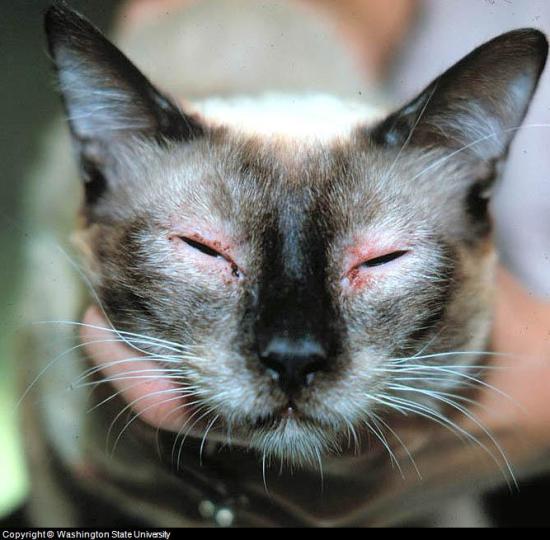
Picture Cat Allergy on Face
(feline allergic dermatitis)
If no infection occurs, hives will usually go away on their
own once exposure to the allergen is removed. Allergies can be caused
by a change in season, if a cat comes in contact with an allergen or
from food. Experimentation is used to determine the exact
cause by changing what is a cat is exposed to, or in the case of food,
limiting the number of ingredients.
If infection develops,
however, medical treatment will be needed. See your vet if your cat has
sores that don’t go away in a few days, or sores that ooze anything
yellowish in color. She may need antibiotics.
Natural Remedies and Feline Skin Lesion
In addition to any specific therapies recommended by a
veterinarian, homeopathic products can provide added support.
Products such as Skin
and Coat Tonic can help to reduce the severity of symptoms,
speed healing, and help to maintain a healthy skin and coat.
References:
Blastomycosis In Dogs and Cats
Adam L. Mordecai, DVM; Perry J. Bain, DVM, PhD; and Kenneth S. Latimer,
DVM, PhD
The University of Georgia, Athens, GA
Scott, D. W., Miller, W. H., Griffin, C. E.Muller
Kirk’s Small Animal Dermatology
Washington State University College of Veterinary Medicine
Ask Our Vet a Question about a Cat Skin Problem
Do you have a question about a cat skin problem? Share it! We'll pick one question to answer each week for free.
Please let us know about the age of the cat, breed, when any cat skin symptoms began, have they changed over time, if your cat is indoor or outdoor, the presence of other pets, changes in your cats routine, bathing frequency, or anything else that will help us understand your cat's medical history, any tests and results.
If possible, please include a picture. Seeing the skin problem can help us improve suggestions made. Please include information such as breed, age, sex, history, changes in behavior, products used etc.
We will try and respond as quickly as possible. If you have an urgent question we suggest using this online veterinary cat answer service that is staffed by vets and available 24 hours a day. You only pay a small fee for answers you accept.
What Other Visitors Have Asked and Vet Suggestions
Click below to see contributions from other visitors to this page...
Cat Food Allergy or Intestinal Problems? 




My cat is approximately 9-10 years old, female, spayed and till six weeks ago never had problems other than occasional fleas. Hard to figure how she got …
Cat Skin Rash Care and Treatment 




Reader Question: What caused my cat to have bloody spots, and break out with bumps around her head?
My kitty Diamond is about a year and a half old. …
Cat With Lesion on Face Not rated yet
Reader Question: Cat Skin Lesions on Head
My cat is a 4 year old Siamese cat..a week ago he developed a cough and started sneezing. I also noticed …
Sore Above Cat’s Eye Not rated yet
My 10-year-old Persian Cat (female) developed a sore over her left eye. About 4 months ago I noticed a small pimple like sore over her eye. It has continued …
Why a Cat's Skin Infection is Healing Poorly Not rated yet
My cat Arthur has had chronic ear infections since I got him as a 2 y/o in 2007. Over the last few weeks, he developed a skin infection on the area beneath …



